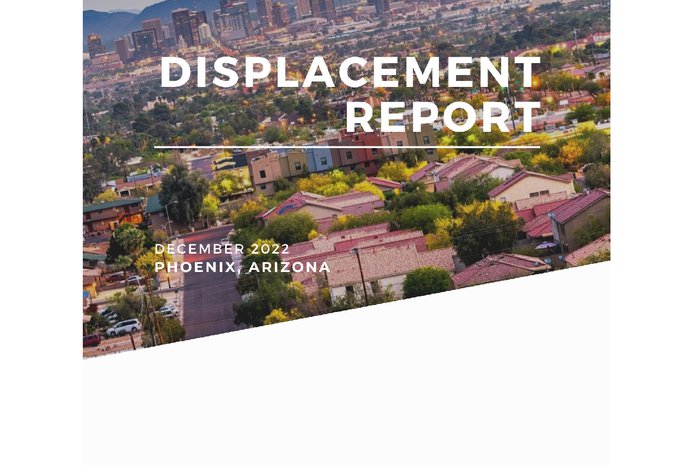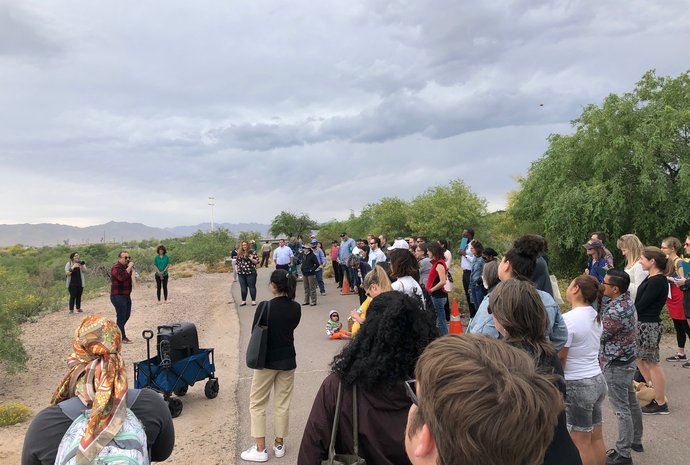Turning the Corner

In 2016 Phoenix was selected as one of five cities across the country to participate in Turning the Corner – a neighborhood displacement project incubated by the The Funders Network’s Federal Reserve Philanthropy Initiative and managed by the Urban Institute’s National Neighborhood Indicators Partnership. In response to wide-spread concern about displacement in redeveloping low income communities, local teams in each city conducted research and engaged residents in strategic thinking about how neighborhoods in heating economies remain affordable and available for everyone.
LISC Phoenix secured Turning the Corner participation, formed a local Steering Group and continues to manage ongoing Turning the Corner activity. Each city conducted baseline research on the shifting dynamics of neighborhood change. In Phoenix, four neighborhoods either on light rail or slated for future rail service – Garfield, Booker T Washington, Eastlake and Glendale – were included in the project. Individual interviews were conducted with neighborhood residents and ASU collected data on changes in neighborhood demography and businesses. Below you’ll find the resulting interactive story map and research report. National briefs and resources have also been released by the Urban Institute.
Story Map
As central Phoenix rapidly grows, this interactive story map is a research tool to document and assess the impact of change in neighborhoods along transit corridors. It provides data that can be used by city planners, government officials, corporate leaders, philanthropy, community nonprofits and neighborhood advocates to better acknowledge shifting neighborhood patterns and create inclusive growth policies and strategies.
Research Paper
A Study of Change and Displacement:
Exploring a methodology for predicting neighborhood changes resulting from construction of light rail
by Arizona State University, W. P. Carey School of Business – Center for Real Estate Theory and Practice, School of Geographical Sciences & Urban Planning – Geospatial Research and Solutions
Articles and Resources
Anti-Displacement Overview
An Anti-Displacement Plan for Neighborhoods Surrounding Downtown Milwaukee – Milwaukee common Council Resolution #171143 (adopted November 28, 2017) directed the Department of City Development (DCD) to prepare an Anti-Displacement Plan for neighborhoods surrounding Downtown Milwaukee.
Urban Institutes Lesson Learned from Five Cities on Displacement Risk – A brief providing lessons about displacement risk in recovering or moderately strong housing markets and recommendations for governments and the civic sector to ensure revitalization benefits longer-term residents.
Turning the Corner Project Overview – Launched in January 2016, Turning the Corner: Monitoring Neighborhood Change to Prevent Displacement piloted a research model in five cities to monitor neighborhood change, drive informed government action, and support displacement prevention and inclusive revitalization.
Housing
Denver Invests in Community Land Trust That Grew out of Anti-Displacement Movement – The Globeville Elyria-Swansea Coalition joined forces with Brothers Redevelopment, a nonprofit housing developer, and the Colorado Community Land Trust in order to incubate a community land trust of its own.
Can a community land trust give long-term residents a foothold in a changing neighborhood? When development reaches its limits in certain neighborhoods, people will look for opportunities elsewhere in the city.
Newtown Community Land Trust Presentation – Land is removed from the market, which give homeownership opportunities for future lower income homebuyer.
The Maricopa Regional Continuum of Care is committed to collaboration and coordination working together towards common goals, we will care for our neighbors and ensure that the county’s residents have access to safe, affordable, and stable housing.
Homeward Bound: The Road to Affordable Housing, is a report from the National League of Cities with an analysis of the factors that caused the housing crisis, case studies of cities implementing innovative solutions and recommendations for both local and federal leaders.
Commercial
Tackling Commercial Gentrification – Healthy communities have local businesses that meet the needs of the people in the neighborhoods they serve. Gentrifications possible negative effects are a threat to the overall health, vibrancy, and strength of communities. Not all communities are affected the same, and areas where rents and land values have yet to go up have the opportunity to take steps to ensure their local business culture can stay intact for years to come.
Gentrification and Small Business: Threat or Opportunity? – The results in this Cityscape: A Journal of Policy Development are mixed and show that gentrification is associated with both business retention and disruption. Most businesses stay in place, and displacement is no more prevalent in the typical gentrifying neighborhood than in nongentrifying neighborhoods. When businesses do leave gentrifying neighborhoods, however, the spaces tend to sit vacant for relatively longer periods of time than they do in nongentrifying neighborhoods.
By Any Other Name: Gentrification or Economic Exclusion? – Though the discourse about gentrification is flawed, it is a huge mistake for urbanists, or those in related circles such as the growing YIMBY movement, to be dismissive of the topic of gentrification, or of the legitimate concerns of those who use the word in relation to their own neighborhoods. Unfortunately, this kind of dismissal from some of my urbanist allies, and in a way that is really harmful to the work of empathizing and coalition-building that these movements instead ought to be doing.
Small Business Profitability Strategies During Retail Gentrification – Seven small business owners with over 80 years of experience in their locations provided input through semistructured interviews and identified effects of gentrification on their neighborhoods and strategies they used to combat retail gentrification. The results of this study might provide small business owners with a toolkit of strategies to assist in staying profitable during a time of change. The implications for social change include the potential for maintaining small business profitability during gentrification, encouraging entrepreneurship, employing local residents, and retaining the authentic culture of the neighborhood.
Does Gentrification Increase Employment Opportunities in Low-Income Neighborhoods? – Gentrifying neighborhoods on average do not experience consistent, meaningful gains in local employment, compared to other comparable low-income neighborhoods that are not undergoing economic upgrading. In fact, there is some evidence that, as a share of all jobs in the census tract, the number of local jobs decreases under circumstances of gentrification.
Keeping the Mission District’s Neighborhood Economy in the Face of Displacement – Mission District of San Francisco, which for decades has been a hub for Latino as an initial place to lay down roots in the United States; however, the Mission is also a place where these immigrants start small businesses as a way to access economic opportunity. To truly turn the tide on the displacement of low-income Latinos from what had once been a welcoming neighborhood to immigrants, MEDA has been focusing on how we integrate our community real estate solutions into the work we have been doing since the late 1970s in keeping cultural and economic assets in the place these newcomers call home.
Opportunity Zones
City of Mesa Prospectus – The City of Mesa has 11 census tracts that have been designated Opportunity Zones by the U.S. Department of the Treasury.
Louisville Opportunity Zone Prospectus – Louisville has 19 Opportunity Zones in 8 distinct geographies, each with highlighted catalytic investments and adjacent investment potential.
City of Erie Investment Prospectus – The city of Erie has unveiled a new document that will help the city make its pitch to prospective developers regarding the new federal Opportunity Zone program.
Phoenix Opportunity Zone Prospectus – Phoenix has 42 zones certified.
PolicyLinks Recommendations for Opportunity Zones – if resources are deployed without a focus on improving opportunities and outcomes for the residents living inside opportunity zones, the investments could lead to displacement of low-income people and communities of color.
Evictions
The Eviction Process in Arizona – An overview of Arizona eviction rules, forms, and procedures
Why Poor Families Move and Where They Go – Despite frequent moves, low‐income black families are more likely than any other group to churn among disadvantaged neighborhoods, and the least likely to escape them.
Urban Institute Research Paper
Why Do Higher-income Households Choose Low-income Neighborhoods – This paper offers several hypotheses about which US higher-income households choose to move into low-income neighborhoods and why.
The Formation of Business Improvement Districts in Low-Income Neighborhoods – This research presents a comparative examination of two neighborhoods in Los Angeles to examine the business improvement districts (BID) formation process in poor immigrant neighborhoods and to identify how community characteristics differ between the neighborhood that succeeded in BID formation and the other that did not.
Rehabilitation, Revitalization and Gentrification – The purpose of this thesis is to show how established settlement patterns, policy decisions, and the resulting built environment promote gentrification and socioeconomic segregation as a means to achieve revitalization in historic downtowns.
Implementing an Equitable Inclusive Development Strategy in the Context of Gentrification – This study provides strategic guidance for the City of Portland to better understand gentrification and its effects; to assess the susceptibility or risk of gentrification for different neighborhoods; and to identify best practices for addressing gentrification and displacement that may be appropriate for Portland.


